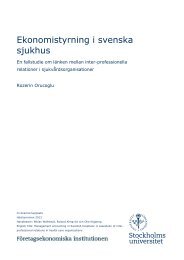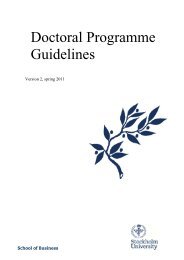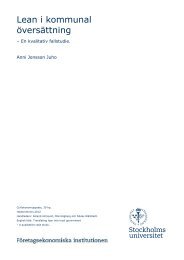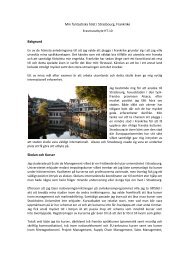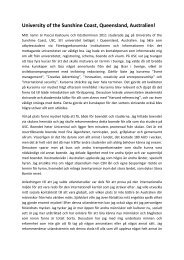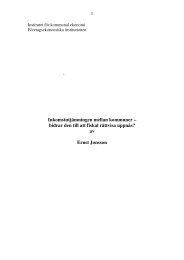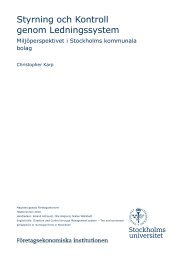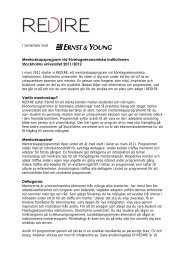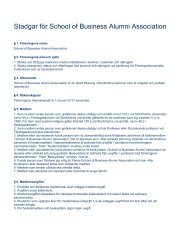Download full programme and abstract book pdf 1.6
Download full programme and abstract book pdf 1.6
Download full programme and abstract book pdf 1.6
Create successful ePaper yourself
Turn your PDF publications into a flip-book with our unique Google optimized e-Paper software.
02:05<br />
Managers in professional services <strong>and</strong> their concept of<br />
managerial leadership<br />
Holmberg, Ingalill; Tyrstrup, Mats<br />
Center for Advanced Studies in Leadership, Stockholm School<br />
of Economics, Stockholm, Sweden<br />
Services provided by knowledge-intensive organizations<br />
(KIOs) are increasingly important to western economies<br />
(Castells 1996). In order to stay competitive, companies<br />
need to provide excellent coaching of co-workers as well as<br />
professional <strong>and</strong> personal development (Majeed 2009). The<br />
expectations on KIOs to innovate are extremely high (Hipp &<br />
Grupp 2005) as is the pressure to run their operations smooth<br />
<strong>and</strong> efficiently (Gadrey & Gallouj, 2002). The in-depth work<br />
which characterizes knowledge-intensive production makes<br />
it a true challenge to simultaneously meet the high st<strong>and</strong>ards<br />
in both areas. One reason emanates from the fact that it is<br />
difficult to single out activities concerned with improvement<br />
from production (Strambach 2008). The evident implication is<br />
that everyday work has to serve as vehicle also for change <strong>and</strong><br />
development. Thus, two questions surface: What conditions<br />
facilitate for people in KIOs to simultaneously be engaged in<br />
production efficiency <strong>and</strong> vital renewal <strong>and</strong> improvement? And<br />
what is required in terms of leadership to uphold the balance<br />
between these two requirements? In this conceptual paper,<br />
examples from KIOs are used to illustrate some challenges<br />
facing leaders in KIOs in terms of being able to promote<br />
change <strong>and</strong> development. According to collaborative research<br />
undertaken with KIOs, it seems as role-expectations concerned<br />
with leadership as well as followership are important. Lateral<br />
communication seems to matter <strong>and</strong> so does organizational<br />
members attitudes towards organizational boundaries.<br />
Hierarchical division of work <strong>and</strong> the degree to which people<br />
engages in informal contacts are also important. In general,<br />
though, the organizational ability to shift between modes of<br />
exploration <strong>and</strong> modes of exploitation seems to be extremely<br />
important. Whereas division of work has long been regarded<br />
as the primary organizing principle in organizations, the<br />
challenges in KIOs seem to stem primarily from issues of<br />
integration <strong>and</strong> a need of integrative perspectives. Thus, the<br />
aiming of this paper is to outline the contours of the integrative<br />
leadership, <strong>and</strong> the activities necessary for coming to grips with<br />
different kinds of organizational “gaps” <strong>and</strong> barriers (Tyrstrup,<br />
2007, Crosby & Bryson 2010).<br />
02:06<br />
St<strong>and</strong>ardization <strong>and</strong> innovation - the Janus-face of service<br />
innovation<br />
Linse, Charlotta; Hallin, Anette<br />
The Royal Institute of Technology, Department of Industrial<br />
Economics <strong>and</strong> Management, Stockholm, Sweden<br />
Innovation is commonly understood as the result of the<br />
development of something new <strong>and</strong> better; often a new<br />
technology, a new product or service, or a new method.<br />
How innovation comes about is a key question for many<br />
businesses today, so also for service companies. For costefficiency<br />
reasons, many companies work with st<strong>and</strong>ardizing<br />
their processes <strong>and</strong> projects which raises the question if there<br />
is room for innovation after having st<strong>and</strong>ardized the workprocedures.<br />
In organization theories, the relationship between innovation<br />
<strong>and</strong> st<strong>and</strong>ardization is depicted as two opposing logics <strong>and</strong><br />
hence problematic, but there is still a lack for empirical studies<br />
of how companies perceive this relationship <strong>and</strong> how they deal<br />
with it.<br />
Our paper presents the result of a comparative, qualitative<br />
study of two professional service companies. The results<br />
show that despite the fear that st<strong>and</strong>ardization may be<br />
counterproductive for individual creativity <strong>and</strong> the creation<br />
<strong>and</strong> development of new ideas, st<strong>and</strong>ardization is perceived as<br />
a means for service innovation. Hence, st<strong>and</strong>ardization <strong>and</strong><br />
innovation can be understood as a Janus-face, rather than<br />
opposites.<br />
The paper thus argues that the tension as depicted in<br />
organization theories between innovation <strong>and</strong> st<strong>and</strong>ardization<br />
is theoretical rather than empirical, but also points to the need<br />
of further studies in order to underst<strong>and</strong> the role of the Janusface<br />
in various service companies.<br />
02:07<br />
International service marketing strategies -St<strong>and</strong>ardization<br />
versus adaptation in Eastern Europe<br />
Nilv<strong>and</strong>er, Frida; Hyder, Akmal<br />
Högskolan i Gävle, Gävle, Sweden<br />
Purpose of the paper - This study aims to describe<br />
international marketing strategies of a service firm, focusing<br />
on st<strong>and</strong>ardization <strong>and</strong> adaptation. It is no longer enough<br />
to recognize that st<strong>and</strong>ardization/adaptation matter in<br />
international business, but it is required to explore why they<br />
exist <strong>and</strong> how they can be implemented so that an effective<br />
marketing strategy can be developed. To go into the depth of<br />
the study, areas of st<strong>and</strong>ardization versus adaptation have been<br />
identified <strong>and</strong> examined in terms of four contents.<br />
Literature addressed - For over 40 years academicians<br />
<strong>and</strong> practitioners have debated on st<strong>and</strong>ardization versus<br />
adaptation of international marketing strategy. Despite<br />
the intense research <strong>and</strong> managerial interest in the topic,<br />
recent articles indicate that the topic of strategy adaptation/<br />
st<strong>and</strong>ardization remains clouded <strong>and</strong> unresolved among<br />
international business academies <strong>and</strong> practitioners.<br />
Research method - Considering the complexity of<br />
st<strong>and</strong>ardization/adaptation dilemma in developing international<br />
service marketing strategy, a case study on a Swedish firm<br />
operating in Lithuania is conducted. Semi-structured interviews<br />
<strong>and</strong> a set of open ended questions have been used for data<br />
collection. Analysis of the data is carried out focusing on the<br />
contents of st<strong>and</strong>ardization/adaption <strong>and</strong> how they influence<br />
on the development <strong>and</strong> implementation of the marketing<br />
strategy in a culturally distant market.<br />
Research findings - Findings of the current study offer several<br />
insights in how the Swedish company has chosen path between<br />
the two extremes - adaptation <strong>and</strong> st<strong>and</strong>ardization. This study<br />
suggests that the service offering <strong>and</strong> its development should<br />
be st<strong>and</strong>ardized while market related adaptations such as<br />
promotion can be based on local culture <strong>and</strong> practices if the<br />
cultural differences are of major importance. Main contribution<br />
- This study makes two major contributions: One is of<br />
conceptual character where external <strong>and</strong> internal antecedents<br />
are linked with the contents of st<strong>and</strong>ardization <strong>and</strong> adaptation<br />
to develop an international marketing strategy for a culturally<br />
distant country. The other is the case study that focuses on the<br />
detail areas of contents <strong>and</strong> how they are implemented in terms<br />
of st<strong>and</strong>ardization <strong>and</strong> adaptation.<br />
Keywords - Services marketing, marketing mix content, br<strong>and</strong><br />
content, service concept content, marketing strategy, cultural<br />
differences, buyer-supplier relationshi<br />
61



